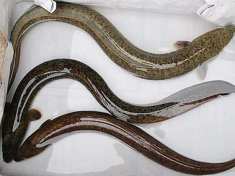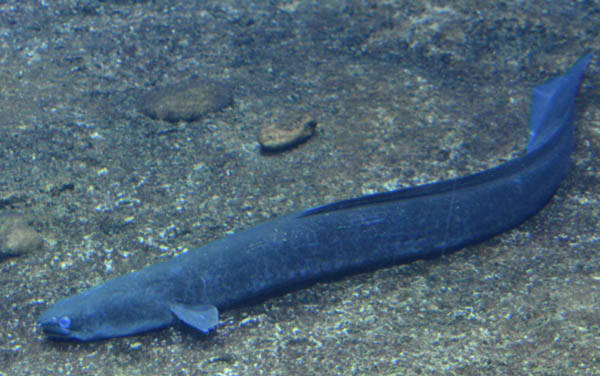
Alias Anguilla marmorata,Marbled eel、Giant Mottled Eel,Big eel, perch eel, flower eel, snow eel, king eel, black ear eel, reed eel, stream eel, stream slide
length 33-61 cm, up to 4 meters
Weight 250-500g, up to 50kg or more
The Latin name of the flower eel is Anguilla marmorata, and its foreign names are Marbled eel and Giant Mottled Eel. There are no subspecies.

In 1824, French zoologist Jean René Constant Quoy (1790-1869) and French naturalist Joseph Paul Gaimard (1796-1858) reported on the Voyage autour de monde, entrepris par ordre du Roi, The first record of flower eels was in the zoology section of fishes (Zoologie Poissons) in the LM "L'Uranie" et "La Physicienne", pendant les années 1817-1820.
For Chinese records of eels, please refer to "Shuowen Jiezi" (122), "Compendium of Materia Medica" (1596), "Kangxi Dictionary" (1716) and "Xin'an County Chronicles" for "eel", "eel", "eel" and other items. The most systematic and clear scientific description of Hong Kong is in the third part of the serial article "A Synopsis of the Fishes of China" by American ichthyologist Fowler Henry Weed (1878-1965) in the local academic journal "Hong Kong Naturalist" Vol. 3 No. 1, 1929, "The Eels", which records the species with two different scientific names, Muraena mauritiana and Muraena bengalensis, but they are actually junior synonyms of the species, and are reported in Guangdong, Macau, Hong Kong, Xiamen, Fuzhou, Ningbo and Zhoushan.
The flower eel is one of the typical downstream migratory fish. It grows in estuaries, swamps, rivers, lakes, ponds, reservoirs, etc. It has a ferocious temperament and a strong and powerful body. During the day, it hides in caves and crevices, and at night, it moves out to prey on fish, shrimp, crabs, frogs and other small animals, and also eats the carcasses of large animals that fall into the water. It can forage in wet meadows outside the water and in bamboo forests and bushes after rain. Its foraging area in the Philippines can reach mountain streams at an altitude of 1523.9 meters. In China, it can reach mountain streams such as Tiantai Mountain, North Yandang Mountain, South Yandang Mountain in Zhejiang Province, Changting in the upper reaches of Hanjiang River in Fujian Province, and Jiangyuan in Changjiang River in Hainan Island. In rivers and lakes, the gonads do not develop; in adults, the gonads begin to develop when they migrate down the river in winter to the river estuary, and then they go into the deep sea to reproduce. In Jiulong River in Fujian Province, China, it lives in caves in rivers and streams from March to July every year.
When the northwest wind blows from October to November, the flower eel begins to move to the estuary and go into the sea to reproduce. The spawning grounds of flower eels are located in the deep trenches between the southern Philippines, the eastern Sri Lanka and Papua New Guinea. After reproduction, the parent fish die and the eggs hatch in the ocean currents. The newly hatched fry are white, thin and soft fronds. After the fronds are carried to the land coast by the ocean currents, they undergo metamorphosis and become short, round, and linear young eels, also known as thread eels, which enter freshwater rivers and lakes to feed and grow. At the mouth of the Dawu River in Taitung, Taiwan Province, flower eel fry about 70 mm long can be seen before the Mid-Autumn Festival. In the Jiulong River in Fujian Province, eel fry enter the estuary between March and April.
Due to the serious pollution of rivers by industrial toxic wastewater and overfishing, as well as the devastating damage to fish resources by poisoning and electrofishing, the construction of dams and reservoirs and hydropower stations have blocked the normal migration channels of flower eels, resulting in a sharp decline in the resources of flower eels, and it is difficult to see their traces, so flower eels are endangered species.
Listed in the "Red List of Endangered Species of the World Conservation Union" (IUCN 2018 ver 3.1) - Least Concern (LC).
Listed in the "Red List of Biodiversity in China - Vertebrates" (Reptiles) - Endangered (EN).
Listed in the "China National Key Protected Wildlife" - Level II.
Listed in the "China Red Book of Endangered Animals" - Endangered (EN).
Listed in the "China National Key Protected Wildlife List" Level II.
Protect wildlife and eliminate game.
Maintaining ecological balance is everyone's responsibility!